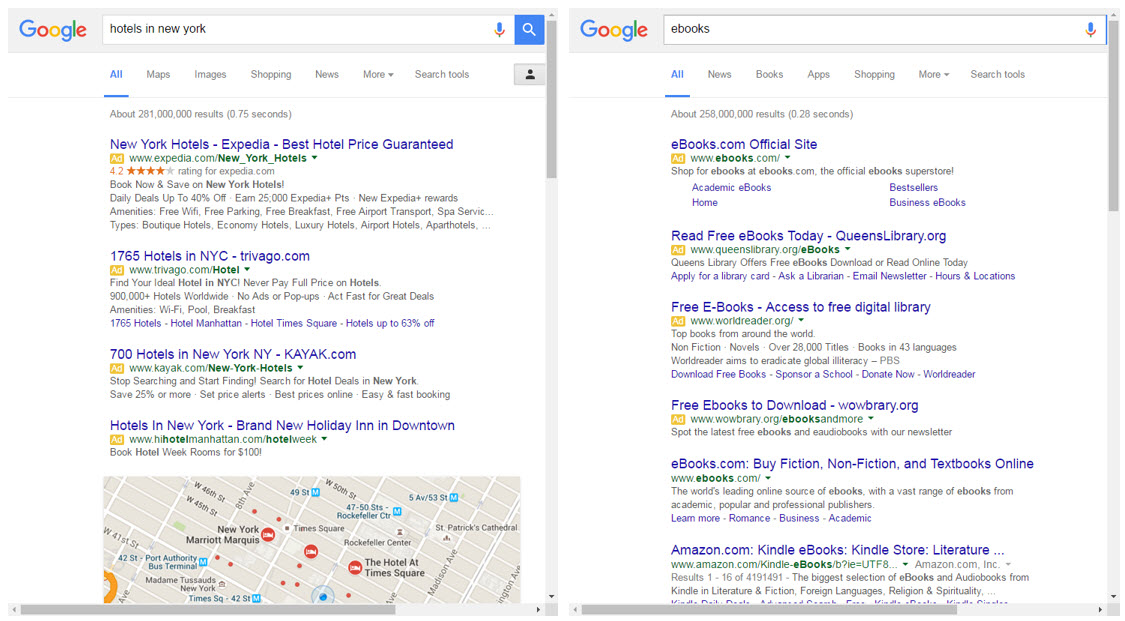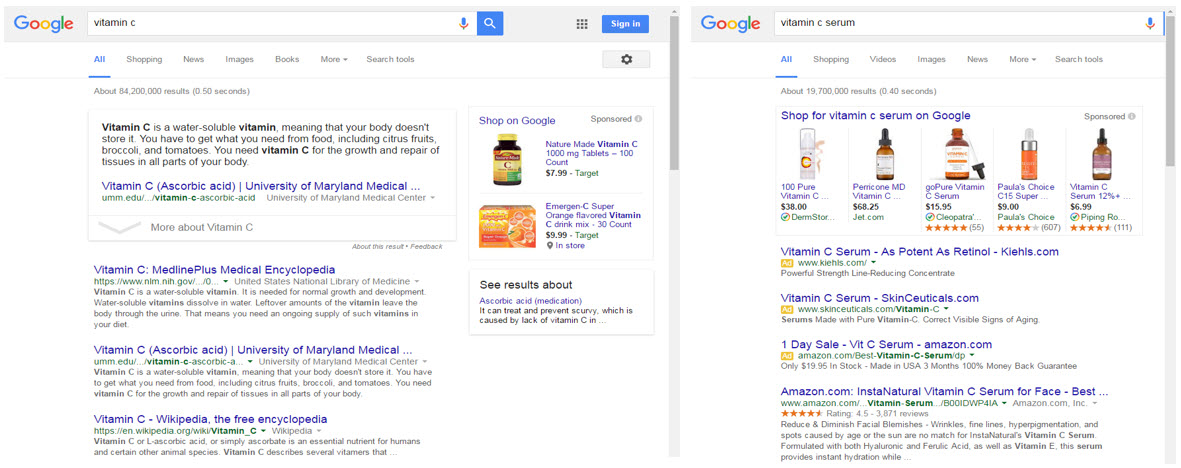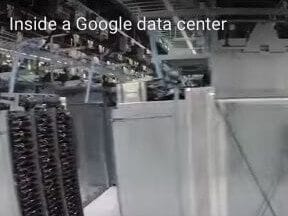In the wake of Google’s move to increase ads at the top of the search results pages while removing side-rail ads, many are focusing on the impact on paid advertising — rising cost per click, increased competition, and the like. However, organic search is affected as well. Devoting more space on search results pages to advertising shrinks the already slim space for organic listings.
In mid-February, Google announced that it was going to change its desktop search results to more closely align with the thin vertical layout of smartphones.
According to Google’s official statement, “We’ve been testing this layout for a long time, so some people might see it on a very small number of commercial queries. We’ll continue to make tweaks, but this is designed for highly commercial queries where the layout is able to provide more relevant results for people searching and better performance for advertisers.”
Google’s desktop search results layout change includes:
- Serving up to four text ads — up from the previous maximum of three — at the top of desktop search results for “highly commercial queries;”
- Removing text ads from the right-hand side of search results served to desktop searchers;
- Serving up to three text ads at the bottom of desktop search results.
The end result of these changes is that organic search results will be sandwiched between up to seven text ads. The ads at the bottom are of less concern to organic search visibility. But the prospect of the first organic search result displaying below four text ads as well as any other organic or paid advertising modules that Google displays, means that even the first organic search result could be displayed below the scroll line for some searches.
Searchers may have to scroll to see even the first organic search result in some cases. In other cases, only the first one or two organic search results are visible on the first screen of desktop results.
For example, the search results below show some examples of what Google deems “highly commercial queries,” in which four text ads are displayed at the top of the page.

Two examples of the new search results pages with four text ads at the top of each.
The example on the left — for “hotels in New York” — shows ads and a local search panel, both of which push organic search results down past the scroll line for searchers. For the “ebooks” search shown at right above, the first organic search result is fully visible at the bottom and Amazon just barely peeks over the bottom edge of the page in view. Everything else requires a scroll.
The old search engine optimization paradigm in which ranking in the top five spots on page one gained you some visibility is long gone. But this new shift makes competition even more difficult by placing SEO value primarily on the first and maybe the second search result listings.
More common high-value ecommerce search results can be expected to look like the examples below, with a mix of Product Listing Ads (PLAs), text ads, and organic search results.

Typical high-value ecommerce search results — for “spring dresses” and “nail gun” — with a mix of paid and organic elements.
Note, however, that only the first one or two organic search results are displaying in these examples as well. Roughly the same amount of space on the page is filled by advertising as is with the page showing four text ads.
In some instances where the search query may be of mixed information and commerce intent, Google may still show ads in the right rail, but only PLAs or possibly ads in Knowledge Panels, which are boxes with business-specific information that appear to the right of search results.
Paid text ads will not display in the right rail. For example, a search like the one at left below for “vitamin C” could indicate a desire to buy a vitamin or a desire to learn more about its health benefits and risks. But Google has determined that a search for “vitamin C serum,” on the right, below, has more commerce intent and therefore shows more ads in a single vertical row with no right rail.

A search with mixed information and commerce intent could trigger PLAs in the right rail.
It may seem like there’s nothing you can do. Google holds all the cards because it alone controls the design of the search results page. This is true. But you control your marketing strategy. Here are some options marketers have to improve overall performance based on the changes to Google’s desktop search results.
- Rank number one. I’m sorry, but it’s true. You will get the most visibility if you can strategize a way to outrank your competition.
- Move to top of second scroll. The best chance you have in organic search results, when you can’t be in first page view, is to be in second.
- Focus on less “highly commercial queries.” Instead of focusing on what you don’t have, focus on what you can win. Identify search queries that are valuable to your business that don’t trigger large numbers of ads and focus more heavily on those.
- Create content to target informational search queries. The high volume of ads is focused on commercial search queries. Get around that roadblock by generating content that answers questions your customers have, offers advice they want, or gives them tools they need to make the right purchase.
Give them something, along with a light call to action or unforced path to purchase, and you may create loyal customers as well as improve your SEO performance.
- Participate in PLAs. If you can’t beat them, join them. Product Listing Ads are becoming a staple of ecommerce search results. They’re visually interesting and they’re always at the top of the page. If you can offer competitive pricing, PLAs may be an option.
- Balance paid search budgets, strategically. This is an interesting dilemma because the answer isn’t to always spend more where you can’t drive performance organically. That’s often a sound strategy, but the opposite can be just as effective.
The second example image above shows a search result for “nail gun.” Notice that Home Depot ranks number one organically. It has also secured the only text ad. Home Depot is also represented in the PLAs. The odds are high that Home Depot is going to sell more nail guns based on this search results page than its competitors, simply because they’re everywhere a searcher could click.



